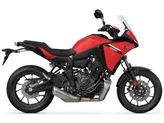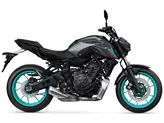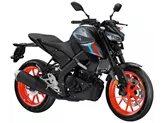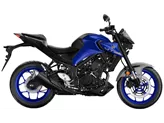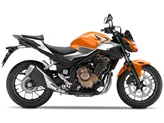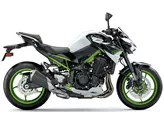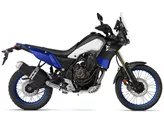Kawasaki ER-6n 2013 vs. Yamaha MT-07 2016

Kawasaki ER-6n 2013

Yamaha MT-07 2016
Vue d’ensemble - Kawasaki ER-6n 2013 vs Yamaha MT-07 2016
The Kawasaki ER-6n 2013 and the Yamaha MT-07 2016 are both naked bikes with similar engine types, inline 2-cylinder engines with liquid cooling. However, there are several differences between the two models.
In terms of engine power, the Yamaha MT-07 2016 has a slight advantage with 75 HP compared to the Kawasaki ER-6n 2013's 72 HP. The torque is also slightly higher on the Yamaha MT-07 2016, with 68 Nm compared to the Kawasaki ER-6n 2013's 64 Nm.
Both bikes have a steel frame and double disk brakes at the front. However, the Yamaha MT-07 2016 has a wider rear tire with a width of 180 mm, compared to the Kawasaki ER-6n 2013's 160 mm. This wider tire may provide better stability and grip during cornering.

Kawasaki ER-6n 2013
The wheelbase of the Yamaha MT-07 2016 is slightly shorter at 1400 mm, compared to the Kawasaki ER-6n 2013's 1410 mm. This may result in slightly better maneuverability and agility for the Yamaha MT-07 2016.
In terms of weight, the Yamaha MT-07 2016 is significantly lighter than the Kawasaki ER-6n 2013. The Yamaha MT-07 2016 has a curb weight of 179 kg, while the Kawasaki ER-6n 2013 weighs 204 kg. This lighter weight may contribute to the Yamaha MT-07 2016's easy handling and agility.
Both bikes have a seat height of 805 mm, providing a comfortable seating position for most riders. The fuel tank capacity is slightly larger on the Kawasaki ER-6n 2013, with 16 liters compared to the Yamaha MT-07 2016's 14 liters.

Yamaha MT-07 2016
In terms of strengths, the Kawasaki ER-6n 2013 is praised for its solid handling and high quality level. On the other hand, the Yamaha MT-07 2016 is known for its very agile engine, very easy handling, low weight, aggressively angular look, powerful brakes, comfortable seating position, throaty sound, and extensive and easy-to-read display.
However, the Kawasaki ER-6n 2013 is criticized for its weak brakes, while the Yamaha MT-07 2016's chassis is considered a little soft and the footrests may drag when cornering. Additionally, the Yamaha MT-07 2016 has some cheap plastic parts and a boring telescopic fork, which may be seen as weaknesses.
In conclusion, both the Kawasaki ER-6n 2013 and the Yamaha MT-07 2016 have their own strengths and weaknesses. The Kawasaki ER-6n 2013 offers solid handling and a high quality level, while the Yamaha MT-07 2016 provides a very agile engine, easy handling, low weight, and an aggressive look. Ultimately, the choice between the two models will depend on the rider's preferences and priorities.
Caractéristiques techniques Kawasaki ER-6n 2013 par rapport à Yamaha MT-07 2016
Avantages et inconvénients en comparaison
Avantages et inconvénients en comparaison
Kawasaki ER-6n 2013

Le moteur est très puissant et amusant, et l'ER brille par sa finition japonaise soignée et son prix compétitif.
Yamaha MT-07 2016

La MT-07 est une incroyable machine de plaisir qui se laisse conduire de manière extrêmement sportive. Le moteur est de loin le plus agile de sa catégorie, et même au-delà.
Comparaison des prix Prix moyen du marché Kawasaki ER-6n vs Yamaha MT-07
There are a few key differences between a Kawasaki ER-6n 2013 and a Yamaha MT-07 2016. It takes less time to sell a Kawasaki ER-6n with 42 days compared to 51 days for a Yamaha MT-07. Since model year 2006 1000PS.de editors have written 16 reviews for the Kawasaki ER-6n and 69 reviews for the Yamaha MT-07 since model year 2013. The first review for the Kawasaki ER-6n was published on 6/29/2005 and now has more than 11,200 views. This compares to more than 12,600 views for the first review on Yamaha MT-07 published on 11/4/2013.


